HEROES OF THE SUPPLY CHAIN
How visionaries created the foundation for today’s operations
› MODEX 2024

Decarbonization

How visionaries created the foundation for today’s operations
› MODEX 2024

Decarbonization
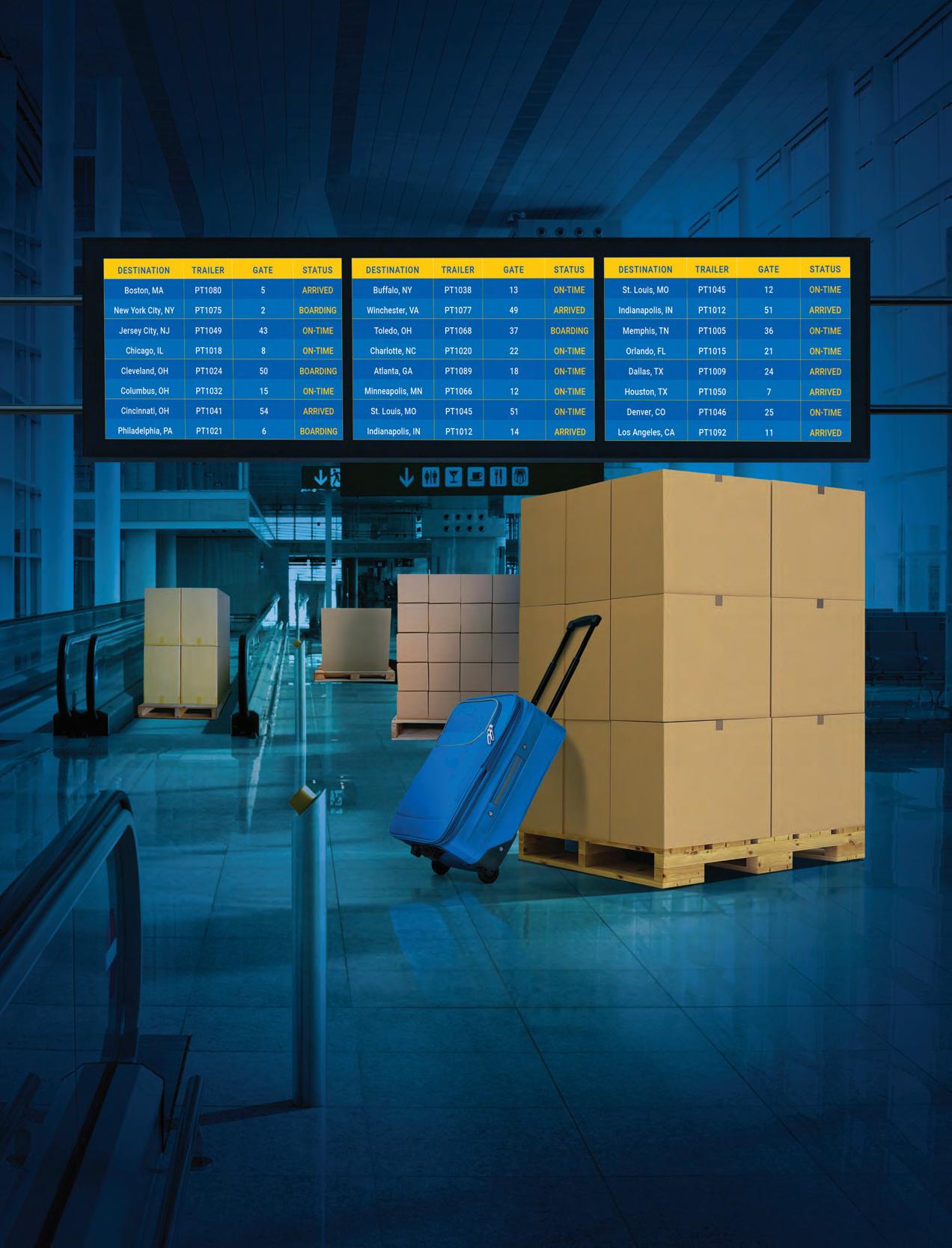
• Daily scheduled Canada & USA departures
• Overnight LTL by 5PM standard arrival times to select destinations
• Priority PlusTM overnight LTL by noon between Toronto & select USA cities
• Industry-leading, over the road cross border transit times
• Simplified process with express border clearances via automation
• Online ordering, real-time tracking & 24/7 customer support
99.21% ON-TIME DEPARTURES 92.15% ON-TIME ARRIVALS







PICK MODULES
MEZZANINES

Publisher | Delon Rashid (416) 459-0063 delon@turnkey.media
Editor | Emily Atkins emily@turnkey.media
Contributing Writers | Seth Catalli, Stephen Dombrowski, Victoria Jones, Constantine Komodromos, Norm Kramer, Christian Sivière
Creative Director | Samantha Jackson
Video / Audio Engineer | Ashley Mikalauskas, Nicholas Paddison
Sales | Delon Rashid, (416) 459-0063 delon@turnkey.media
Peter Bulmer, (585) 653-6768 peter@turnkey.media
Production and Ad-ops | Tracy Stone tracy@turnkey.media
Inside Logistics magazine is published by Turnkey Media Solutions Inc. All rights reserved. Printed in Canada. The contents of this publication may not be reproduced or transmitted in any form, either in part or full, including photocopying and recording, without the written consent of the copyright owner. Nor may any part of this publication be stored in a retrieval system of any nature without prior consent.
Canada Post Canadian Publications Mail Sales Product Agreement No. 43734062
“Return Postage Guaranteed” Send change of address notices, undeliverable copies and subscription orders to: Circulation Dept., Inside Logistics magazine, 48 Lumsden Crescent, Whitby, ON, L1R 1G5
Inside Logistics magazine (ISSN No.: 0025-5343 (Print); 1929-6460 (Digital) is published six times per year by Turnkey Media Solutions Inc., 48 Lumsden Crescent, Whitby, ON, L1R 1G5
From time to time we make our subscription list available to select companies and organizations whose product or service may interest you. If you do not wish your contact information to be made available, please contact us.


YOU WOULD NEVER have known that economic doom and gloom were in the forecast if you walked the show floor at MODEX 2024. The semi-annual trade show in Atlanta was absolutely vibrating with activity. At some points during the three days I was there it was virtually impossible to shove your way taking in the throngs of visitors.
They were taking in displays by more than 1,200 exhibitors that ranged from the humble but necessary – caster wheels – to the almost fantastical – robots hand-balming goods out of a truck, completely autonomously. The range and scope of the innovations on display was mind-boggling. But, perhaps more significant was the sense of expectation and excitement from both vendors and visitors. According to MHI, which organizes the show, not only were there 32 percent more visitors this year than in 2022, they have money to spend.
The MHI annual report (see page 6 for a complete write-up of the findings), which it produces with Deloitte, found that companies have allocated budgets for supply chain investments. More than half of respondents plan on increasing investments, with almost 90 percent saying they plan on spending more than US$1 million. And a remarkable 42 percent have more than $10 million ready to go.
This does not sound like a reflection of worry about recession. It sounds to me like a very robust response to increasing demand, and a growing need for digitization and responsiveness. Companies need visibility and agility in order to be competitive right now. A vast number of the services and products on display at MODEX were designed to meet this need.
And it’s not just at MODEX that this trend is evident. There’s a growing impulse for manufacturers and retailers to look beyond China for sourcing. Rapidly changing geopolitics is forcing a rethink for many as they seek to secure supply and protect themselves against protectionist trade regulations, such as China has recently implemented, and physical conflicts like the attacks on shipping in the Red Sea or the ongoing war in Ukraine.
“Supply chain managers are still coming to terms with the political and economic instability characterizing the post-COVID global economy, “ said John Manners-Bell of Ti Insight. “Geopolitical relationships are changing rapidly, and this is having a major impact on international trade and risk profiles.”
Corporate Office
For the moment, it would seem that these changes are spurring on the suppliers who serve supply chain operations to innovate, while users snap them up.

ARTIFICIAL INTELLIGENCE (AI) is the top technology under scrutiny in this year’s annual report from the Material Handling Institute (MHI).
The report, “The Collaborative Supply Chain: Tech-forward and Human-Centric”, was released at the 2024 MODEX show in Atlanta in March. It found that 55 percent of supply chain leaders are increasing their supply chain technology and innovation investments. And they’re planning to spend big: 88 percent said they are planning to spend over US$1 million, while 42 percent plan to spend over $10 million.
The report looks at the innovative technologies that have the most potential to transform supply chains in a way that maximizes performance gains while at the same time empowering workers. Supply chain leaders play a pivotal role in creating and enhancing this balance between technology-driven and human-centric approaches, the report said.
“The focus on technology in supply chains is undeniable. But supply chains are run by people, and human-centricity is the key,” said John Paxton, CEO of MHI.
“A human focus on technology implementation encourages the kind of creativity and innovation that builds stronger, more streamlined operations. It also attracts new hires, retains current workers, and empowers team members to higher levels of safety and performance.”
Price increases due to inflation are the biggest supply chain challenge, cited by 53 percent of survey respondents. However, this was followed closely by the talent shortage (52 percent), customer demands (51 percent), insight into customer behavior (50 percent), and supply chain disruptions/shortages (50 percent).
These challenges are spurring companies to deploy digital technologies to make their supply chains more responsive and resilient, helping them adapt to changing market conditions, anticipate disruptions, and seize new opportunities, the report found.
The survey found that firms are using technology to enable human workers. Forty-five percent are using technology as an enabler for human decision-making, to improve sustainability/visibility (42 percent),
“AI has the potential to create more resilient supply chains and transform the role of human workers in the space – creating a variety of new jobs and improving real-time decision-making and efficiency.”
– John Paxton, CEO of MHI
and to empower human workers (40 percent).
“Successful firms are dedicating training resources to build the bridge between supply chain technology and the human workers,” said Wanda Johnson technology fellow at Deloitte Consulting LLP, which co-wrote the report.
AI adoption and interest are at historic levels, with 84 percent of survey respondents now reporting plans to adopt artificial intelligence technologies within the next five years. One of the key challenges noted is to understand and plan how to benefit from AI tools (and how quickly to implement them).
AI has the potential to be a powerful tool for improving supply chain resiliency and enhancing worker productivity, satisfaction, and retention. It can be used to rapidly adjust training methods; empower teams to develop new skills; and increase the capabilities, and performance of individual workers through collaboration with a suite of AI helpers. AI can also help leaders make dramatically better, faster, and more confident decisions by rapidly gathering and analyzing diverse data sets and then generating advice that is relevant and usable.
Adopting an approach to AI that is technology-driven, human-centric, and collaborative is crucial to long-term supply chain success – boosting productivity and empowering workers to achieve higher levels of performance and innovation than ever before.
“AI has the potential to create more resilient supply chains and transform the role of human workers in the space - creating a variety of new jobs and improving real-time decision-making and efficiency,” said Paxton.
This year’s survey reveals five key trends impacting supply chains that will dictate the course of action and focus for industry leaders moving forward. These key trends impacting supply chains are:
1. Agility as geopolitical concerns and ongoing risks are impacting operations. Organizations need to ensure their supply chains centre on flexibility and adaptability in the face of dynamic market conditions, geopolitical risk, and growing reshoring initiatives.
2. Rising costs, including inflation and cost of capital. While inflation is easing in the U.S. firms will need to monitor and strategically manage rising costs globally, particularly in Europe.
3. Supply chain workforce including the talent shortage and changing skill sets. Automation is increasing overall worker satisfaction by making jobs better and more tech-forward. However, culture and flexibility are key in recruiting, retaining, and re-skilling a high-achieving workforce.
4. Sustainability and environmental, social, and governance
(ESG) measurement and reporting regulations are on the near horizon and organizations are working with their suppliers to meet coming Net Zero goals and responding to risks associated with climate-related disruptions.
5. Visibility and transparency goals are compelling leaders to prioritize technology-driven investments and supplier collaboration.
The report also provides real-world case studies of digital supply chain technologies and recommendations for leaders to develop strategies to implement these innovations.
The 2024 report is based on survey responses from over 1,700 manufacturing and supply chain industry leaders from a wide range of industries at the end of 2023. Eighty-one percent of respondents hold executive-level positions such as CEO, vice president, general manager, department head, or engineering management. Participating companies range in size from small to large, with 75 percent reporting annual sales of more than $50 million, and 17 percent reporting $1 billion or more.
TEN INTERNATIONAL ORGANIZATIONS have joined forces to combat wildlife trafficking. The initiative is led by the World Shipping Council, supported by United Nations Development Program, the Global Environment Facility, and the Global Wildlife Program, in collaboration with TRAFFIC and WWF, and co-sponsored by BIC, Global Shippers Forum, the International Fund for Animal Welfare and TT Club.
Together, they have produced practical guidelines for all supply chain participants, with advice on measures to take, questions to ask to help identify criminal wildlife trade, and guidance on reporting suspicious activities. An accompanying "Red Flags" document serves as a daily reference for all individuals involved in the supply chain.
Illicit trafficking of wildlife not only endangers countless species but also undermines the stability of ecosystems and jeopardizes the livelihoods of communities worldwide.
“We recognize the critical role that the maritime industry plays in combatting illegal wildlife trafficking. By working together to increase awareness across the supply chain of how to spot and address this criminal activity, we can prevent the exploitation of global maritime supply chains for criminal activities and protect endangered species worldwide,” says John Butler, president and CEO of the World Shipping Council.
With the vast volume of trade carried by sea, the demand for faster, just-in-time deliveries and the increasing complexity of intermodal supply chains, criminals increasingly exploit weaknesses

in global maritime supply chains to traffic contraband items.
Combatting illegal wildlife trafficking is a shared responsibility that requires collaboration across international containerized supply chains. All parties involved, especially consolidators and those receiving goods for packing or carriage, must take proactive steps to prevent the shipment of illegal wildlife. This includes verifying the legitimacy of cargoes, properly sealing shipments, conducting risk assessments, and promptly alerting national authorities to suspicious activities, as appropriate.
GLOBAL LOGISTICS EXECUTIVES, still worried about recession, say they are battling higher costs, reducing dependence on sourcing from China, and planning to boost investment in Africa despite seeing emerging markets investment overall as somewhat riskier.
Half of the 830 industry professionals surveyed by Ti Insight for the "2024 Agility Emerging Markets Logistics Index" expect a global recession in the coming year – down from nearly 70 percent a year ago.
More than 63 percent of respondents say their companies continue overhauling supply chains by spreading production to multiple locations or relocating it to home markets and nearby countries. China, the world’s leading producer, stands to be most affected: 37.4 percent of industry professionals say they plan to move production/ sourcing out of China or reduce investment there.
Shipping and logistics costs that soared during the COVID pandemic and its aftermath are still climbing but at a slower rate, the survey found. One way shippers expect to cope is by increasing use of digital freight forwarding from 37.8 percent today to 52 percent in five years.
Meanwhile, the industry is gearing up for a surge in Africa investment. Nearly 62 percent of professionals say their companies are
“Businesses are worried about geopolitics – troubled trade relations between China and the U.S. and Europe, and the thicket of sanctions against a growing number of countries.”
– Tarek Sultan, vice chairman, Agility
planning additional or first-time investments in Africa versus only about seven percent exiting.
“Shippers and carriers are struggling to minimize supply chain risk and find new growth opportunities. Inflation and recession risks have eased, but the industry is still living with the aftershocks of the COVID pandemic. At the same time, businesses are worried about geopolitics – troubled trade relations between China and the U.S. and Europe, and the thicket of sanctions against a growing number of countries,” said Agility vice chairman Tarek Sultan.

GardaWorld offers a comprehensive, multi-service security approach for your logistics and warehousing facilities, providing a wide range of solutions to meet your unique challenges.
INDUSTRIAL CONSTRUCTION STARTS have slowed dramatically as both tenant demand has waned and hurdles to new construction activity have grown. Cushman & Wakefield released the finding in its "Q1 U.S. Industrial Construction Overview" in March.
“After a pandemic-infused, over-stimulated economy pushed consumer demand for durable goods to record levels in 2021 and 2022, industrial facilities were constructed at a feverish pace to meet occupier demand. Over 1.8 billion square feet (bsf) of industrial product has been delivered since the beginning of 2020, more than was constructed in the previous decade,” said Jason Price, senior director, Americas, head of logistics and industrial research.
The report shows that as economic uncertainty has persisted amid elevated inflation and high interest rates, occupier demand has moderated, leaving 52 percent of the newly built facilities in 2023 still available for lease and causing vacancy rates to increase nationwide. As a result, new starts have slowed dramatically, and the under-construction pipeline has been shrinking – a phenomenon that will continue in 2024.
The industrial pipeline peaked in Q3 2022 at more than 716 million square feet (msf) but has fallen each quarter since. On an annual basis, the pipeline has dwindled by 33.7 percent. This is due to the record pace of new deliveries in the second half of 2023, coupled with the pullback on construction starts.
Each of the past four years set a new record for industrial construction deliveries, topping out at 610 msf in 2023. After averaging just 169 msf of annual deliveries over the previous decade, the U.S. industrial market saw those totals more than triple, delivering over 1.1 bsf over the last two years. The surge in development was in response

to historic tenant demand coupled with record-low vacancy rates in many markets across the country.
“Looking forward, Cushman & Wakefield expects almost 490 msf of new product to deliver from 2024 through 2025. Amid softer demand totals, vacancy will continue to rise this year before stabilizing in 2025. However, some markets could quickly become supply constrained as construction activity slows down,” Price said.





SUPPLY CHAIN PROFESSIONALS can spend nearly 14 hours per week – almost two full workdays – manually tracking data. A survey of 250 supply chain, inventory, and planning executives has revealed these inefficiencies in the sector.
“In a rapidly evolving market, this inefficiency points to a significant loss in productivity and a barrier to effective day-to-day decision-making, not to mention grave concerns about their ability to prepare for the next major supply chain disruption,” said Richard Lebovitz, CEO of LeanDNA, a supply chain software supplier, and sponsor of the research.
While most supply chain executives plan to increase investments in proactive supply


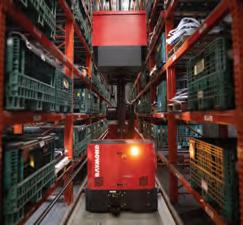
Build smart. Stay agile. Now is the time to take a broader look at your overall intralogistics strategy and optimize. Making adjustments to combat today’s challenges will prepare you for a strong and sustainable future. And we can help.
Together, we’ll analyze the strategy and systems you’ve built to move, manage, store and protect goods and bring forward new ideas to enhance or secure the investments you’ve already made. Let’s get started.
chain management (92 percent), 76 percent do not currently have a predictive view of supply and demand.
The absence of predictive data has companies operating as though they have no data at all. The vast majority of supply chain execs (92 percent) make gut decisions sometimes or more due to a lack of predictive guidance in their reports.
The confusion and chaos of the COVID-19 pandemic, natural disasters, geopolitical conflicts, and more inform how executives anticipate a disruption affecting their organization in 2024. Executives predict a supply chain disruption could impact their workforce — meaning potential layoffs or other labour impacts (47 percent) and reduced productivity (45 percent).
A third of supply chain executives fear the next disruption will mean revenue loss, but stocking up is also a costly or infeasible option. This explains why 96 percent face pressure to balance preparedness for a major disruption with avoiding excess inventory.
Barriers to using real-time data for supply chain management include the current tech not supporting real-time data (44 percent) and lack of staff skills and training (55 percent). For some, upgrading their tech doesn’t seem like an option: 48 percent report their current system is too ingrained, and another 26 percent believe their organization can’t afford the implementation disruption.
More than four in five leaders (82 percent) agree that real-time data that does not provide actionable insights for decision-making is a waste of time and energy. While 82 percent report having some level of a real-time view of supply and demand, only 24 percent have a predictive view, giving those companies a leg up when it comes to being able to take action and make decisions based on the insights. Supply chain executives are gearing up for future disruption with 92 percent of supply chain executives planning to ramp up investments in preparedness strategies. 87 percent are focused on resilience as a high priority, including 41 percent who put it at the top of their list.
An impressive 86 percent of supply chain leaders report their organizations have already made major changes to their processes or tech stack to improve preparedness for the next major supply chain disruptions. Over one-third (33 percent) have gone through a complete overhaul. This includes 41 percent that diversified their supply base, 39 percent that identified new or better vendors, 36 percent that re-trained their workforce, and 32 percent that partnered with third-party logistics experts.
Walmart Canada has made changes to its leadership team, including those responsible for supply chain and operations. John Bayliss has been promoted to chief operations officer, leading an expanded portfolio that includes store operations, supply chain, format and real estate development. Most recently, he was chief administration officer. Matt Kelly has been promoted to vice-president, supply chain. He was previously vice-president, supply chain transformation, where he was responsible for leading Walmart Canada's supply chain infrastructure program. Joe Schrauder has been appointed vice-president, head of store operations. He was previously vice-president, operations and chief of staff to the CEO, leading the project management office and had responsibility for the central operations, and the future store operating teams. Before joining Walmart Canada in 2023, he held the role of vice-president, international operations and realty, Walmart International. He has spent his career with Walmart, beginning in-store and dedicating over 20 years to Walmart U.S. and international operations.
CN has appointed Remi Lalonde as executive vice-president and special advisor to the CEO in anticipation of his transition to the role of chief commercial officer (CCO) of CN later in the year. Lalonde is spending his first months on the on the job at CN learning about scheduled railroading, servicing customers, and executing CN’s planning model. Once this familiarization is completed, Lalonde will transition into the role of executive vice-president and CCO. Doug MacDonald, CN’s current executive vice-president and chief marketing officer, will remain in that role until the transition is completed later this year. Lalonde is the former president and CEO of a Quebec-based forest products company. He earned a Bachelor of Laws and a Bachelor of Environmental Engineering from the University of Ottawa.
Terry Wills will step into the position of chairman, advisory board of Wills Transfer Ltd, while Jordi Wills is the company’s new president. Jordi, who joined Wills Transfer full-time in 2013, has held various roles throughout his tenure. Terry is the former
president and third-generation leader of the family-owned enterprise.
Two new directors have been appointed to WorkSafeBC’s governance board. William Laird Cronk, representative of the public interest, was appointed as a director, and Anil Kumar Niranjan Singh, representative of law or law enforcement, was appointed as a director. Both terms end Dec. 31, 2025. The WorkSafeBC board of directors serves as a steward of WorkSafeBC and the workers’ compensation system.
Kale Info Solutions has appointed two sales professionals in North and South America. Maureen Kam has assumed the role of vice-president sales, Canada, and Camilo Navarro is now the sales manager for South America. Kam brings over 20 years of airline experience leading teams in global sales and digital transformation programs across Asia, the South Pacific, and North America. Navarro has 35 years of cargo management experience in Colombia and the Americas.


https://survey.alchemer.com/ s3/7773895/Shippers-24-Web
A FEW SHORT MINUTES IS ALL IT TAKES.
The 2024 Shipper’s Choice Awards are now open, and we want to hear from you!
Please take a few minutes to rate the performance of the Canadian carriers you rely on for your business.
If you choose, you can enter for a chance to win a $500 gift card.
Your feedback will not only help us set benchmarks for carrier service in each mode, it will also identify the country’s best carriers.
The results will be published in the August 2024 issue of Inside Logistics.
Take our survey today, and have your say!


The supply chain. Not too long ago, many people didn’t quite understand it nor had even heard of it.

Then 2020 happened and the terms “supply chain” and “toilet paper” became synonymous. Now, a few years removed from the great pandemic, people are starting to forget about the supply chain again – until a product they need is not readily available on the shelf or online.
However, with each challenge, more innovators are stepping up to the plate to solve problems and bring the supply chain into a new era. Like Marco Polo exploring the Silk Road, supply chain innovations have always been built by visionaries who wanted to expand on the definition of success and take chances with new ideas.
It is difficult to determine whose historical innovation has been the most influential on the supply chain. Could it be the barcode? Inventors Norman Joseph Woodland and Bernard Silver took Morse Code and translated it into black bars that can hold unique, programmable information and allow products to be tracked. What about refrigerated “reefer” trucks, devised by Frederick McKinley Jones, which allow perishable foods to be transported further distances than ever before?
It could be the software system created by Josef Schengili that helped pave the way for Advance Planning and Scheduling, helping manufacturers optimize production schedules to maximize customer service and production efficiency.
One question to ask when observing a true historical giant in the supply chain, someone who not only created a tool but an entirely new
The creation of modern-day supply chain and logistics is often credited to Sam Walton, creator of Walmart, a company that pushed back at other large stores and offered quality goods and services at competitively low prices. It wasn’t the affordability that Walton and others credit for Walmart’s success, but rather the approach of replacing inventory with information.
In other words, Walmart takes full advantage of its digital data to stay on top of its sourcing, stocking, and fulfillment. Walmart’s push for information transparency in its supply chain has allowed the company to control pricing and maintain dependable catalogs.
Fred Smith, founder of Fedex, also wanted to deliver dependable services. He saw the world automating and with this influx of automation and technology, businesses and people would need things faster.
His supply chain dilemma was how to deliver overnight hundreds of thousands of packages going any number of ways. His solution: the Federal Express wheel, consisting of a spoke and hub model where all planes had to land at one location. From there, all packages were sorted to where they needed to go, and planes flew out of the central hub to single delivery destinations.



Once that was determined to be successful, Smith knew there was a need for traceability in the supply chain. That led to the creation of the SuperTracker to track all the packages that were coming into the central hub. Employees had a handheld barcode scanner to record the package in the system as it was picked up and delivered.

the most profit per car. However, when those just-in-time supply chains can’t deliver at a minute’s notice, there is nothing to fall back on.
Up-to-the-minute data – and the management of it – is essential in supply chain fulfillment.
Manufacturing and the supply chain are a cycle. Many people think of a linear journey: it starts with procuring a material and ends with the production of a product.
But it is more than that. It is a repetitive cycle that needs to be monitored and managed constantly, or it can quickly spin out of control. Before an order can be fulfilled, manufacturers must procure the materials to make the finished goods, and they often face problems in sourcing. Certain automotive giants recognized that controlling sourcing in the supply chain was imperative, but each approached it differently.
Kiichiro Toyoda, creator of the world-renowned Toyota Motor Corporation, is best known for his Toyota Production System (TPS) that made the corporation an automotive production leader. A major component of TPS is the Just in Time (JiT) principle, which cuts costs and waste by only creating what is needed at one time. Less inventory management, waste cleanup, and storage costs are required because
Henry Ford, of Ford Motor Company, was wary from the start of supply chain shortage issues. While Ford is most known for his moving assembly line, the lengths he went to to fuel those production lines continuously are most impressive. Ford not only sourced the raw materials, but he bought coal mines, iron mines, and forests, on top of owning the railroads and ships needed to transport the materials. Ford was always aware that a supply chain shortage could halt production, and he wanted to control as much of the chain as possible.
Unfortunately, to keep up with modern technology and cut costs, Ford Motor Company did start outsourcing production of computer chips to Taiwan, and they now are experiencing a shortage that has impacted production. Conversely, Tesla, headed by Elon Musk, saw this supply chain shortage risk and brought production of computer chips in-house with Tesla’s Gigafactory. While it was an up-front cost to gamble, Tesla has what few other manufacturers have: control over chip production to ensure realistic timelines and full control over programming.
One of the best ways to stay ahead of a supply chain crisis is to focus on the resources that are readily available. The people who excel don’t
stop there, they then take what they have and imagine it in new ways. In the 1920s, a journalist asked Thomas Edison how it felt to fail 1,000 times in his attempt to invent the incandescent lightbulb. Edison replied, “I didn’t fail 1,000 times, the lightbulb was an invention with 1,000 steps.”

Ray Kroc reimagined processe at McDonald’s, the company he purchased from the McDonald’s brothers in 1961, and then globally expanded and ran as CEO until 1973. Kroc is most known for his influence on McDonald’s efficient assembly line, allowing the food to be pieced together faster step by step and with machine assistance than could ever be done by one chef creating a meal from start to finish.
Kroc was obsessed with consistency. He pushed to standardize the menu, which helped create brand continuity for the customer and internal company control over supply management. By
making and pricing all of the burgers the same at each location, the con tinuity made predicting profit, overhead, and supply orders easier for the company.
Customers want the same product regard less of which restau rant they are visiting. Kroc went as far as standardizing suppli ers: the same type of potato had to be used for all french fries. This guaranteed the same experience whether you were in Chicago or Hong Kong. McDonald’s returned to this philosophy during COVID when it created a limited menu. This ensured that the fast-food giant only promised customers what it could depend on receiving at all major locations.

Perhaps the greatest push for innovation under Kroc’s leadership was the invention of the Big Mac in 1967. To compete with Burger King’s new Whopper, an owner of a Pennsylvania McDonald’s, Jim Delligatti, created the Big Mac. A year after its creation, Kroc added the Big Mac to all McDonald’s menus.
24_001491_Inside_Logistics_APR_CN Mod: March 5, 2024 3:56 PM Print: 03/18/24 page 1 v2.5
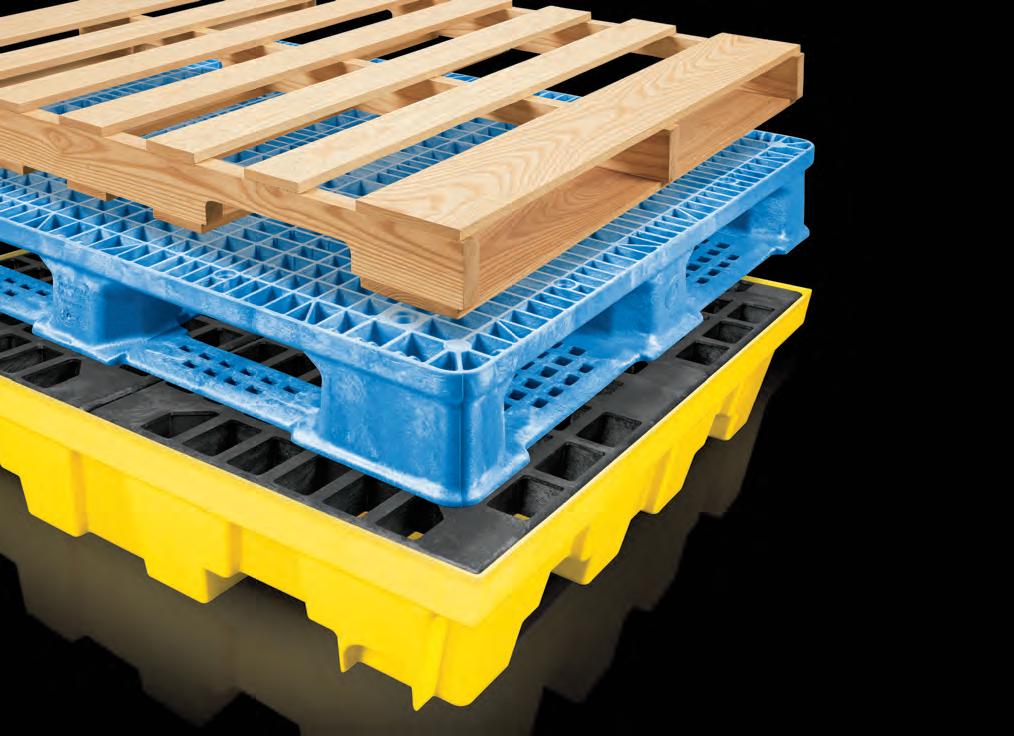
ORDER BY 6 PM FOR
Why is this such an accomplishment? McDonald’s Big Mac took the same ingredients readily available at all locations to create the stacked burger. Unlike the competition, no larger items or new ingredients delayed fulfillment in supply chain shortages. Not only did this allow for the new product to be introduced quickly, but no additional or unexpected costs were incurred. McDonald’s approach to repurpose what was already in their supply chain is what other companies can challenge themselves to do.
While some companies utilize what they have in different ways for new products, other companies are allowing the customer to be the one to think outside the box, or rather the buttons. In 2007, Steve Jobs launched the first iPhone with its characteristic touchscreen because he thought that buttons limited what could be accomplished. And while it was not the first touchscreen phone on the market, it had a longer battery life, more capabilities, and – most importantly – it was customizable.
With the iPhone, users have power over what functions, apps, and layout their phone has. By not boxing the user in, they will never run out of options and have less need to look elsewhere for a different product. One single screen that can be customized also saves on production costs and sourcing since new materials are not needed for one person’s iPhone versus another’s.
All these supply chain visionaries faced true challenges to their brands and not only overcame them, but also created systems and processes that others had to adopt in order to stay relevant and competitive. These lessons in maximizing creativity, creating product dependability, and controlling the supply chain have brought the modern supply chain to where it is today.
However, the reality is that companies cannot rely on those thought leaders to assist with supply chain problems today. Instead, these giants should inspire business leaders to create the next big idea, just like they once inspired their own people.
Great ideas have to start somewhere, and a great starting point is in in-house supply chain management systems. New challenges will arise and new ideas will be needed to overcome them. Something perceived as a small fix may become standard practice in years to come.
One uniting catalyst for all these supply chain giants is that they had to take a risk. Many of these ideas that led to success could have easily led to failure. These pioneers realized that and stared fear in the face to take a chance.
Franklin Roosevelt once said: “We have nothing to fear but fear itself.” He was correct. When someone takes a chance with a new idea, yes, failure is a possibility – but so is success. Where would we be today if the inventors of the wheel yielded to fear?
Stephen Dombrowski is director, consumer Markets, at QAD.

Get Connected: www.hcforkliftcanada.com sales@hcforkliftcanada.com
Hangcha Canada makes its debut with a new take on
THERE’S A NEW PLAYER in Canada’s forklift marketplace, and they are bringing a whole new way of operating to their customers.
Hangcha Canada, or HC Forklift Canada, opened in 2019 here, but they are already making a big splash with their unique go-to-market strategy. The company has established three warehouses, in Montreal, Mississauga, Ontario, and Vancouver, which allows them to keep 600 forklifts on hand at any one time. They offer factory-direct pricing, and they are working with 20 dealers across the country, and the network is growing.
“We are a disruptor in the market right now with our pricing and having 600 trucks at any given time in stock in Canada, no one else does that,” says John Sedlacek, the company’s national accounts director. “We are doing a very good job as far as an OEM supplier and support for our dealers and for our clients. No one else has that investment with that kind of volume in Canada right now. It obviously helps me in my sales process when I can say I can deliver next week.”


Hangcha Group has been manufacturing material handling equipment since 1956. And although it’s not yet a household name here in Canada, the company is growing its market share rapidly and opening branches around the world. Its US office opened in 2018, and after the Canadian branch started up, it’s been joined by the Netherlands, Australia, Mexico and Brazil.
Hangcha can produce 400,000 units a year from its advanced facilities in China, and is constantly working on new product development. It spends about US$98 million a year and employs over 1,000 engineers to test and improve what it builds.
Hangcha prides itself on the quality of its forklifts. It uses components sourced from the world’s best manufacturers in its products. The company’s parts are built by suppliers like Bosch and Eaton, Cummins and Kubota, among many others, and it gets front ends from North American supplier Cascade. The company partnered with battery manufacturer CATL in 2018 to ensure its supply of safe and efficient lithium-ion batteries.

The Hangcha electric forklift story is one that Sedlacek is excited about. There is a movement in Canada now to switch from internal combustion forklifts to electric, he says. Companies have decarbonization mandates to meet. And Hangcha offers a wide array of electrified products (see sidebar) that are reasonably priced.
“Our lithium is so affordable compared to what it used to be. That’s up to like 70 percent savings, the savings over the course of five years is incredible when you start doing the math,” Sedlacek says.

And even customers who start out saying they are not looking at electric forklifts will end up taking a couple electric ones when they see the demo and go through the ROI calculations, he adds. Of course, there are a lot of factors to consider when converting, like the availability of power to a facility, so Sedlacek underlines that for every lithium-ion-powered truck, Hangcha also offers a gas or diesel option for the customers who aren’t yet ready for electric.
As national accounts director he is busy promoting the company’s forklifts to a variety of industries across the country. He’s targeting logistics companies, rental firms and other sectors.
The national accounts program has just been launched, and emphasizes Hangcha’s ability to offer custom solutions across the full Class 1 through Class 7 range of products, along with the factory-direct pricing and unparalleled support across the country. And, if a customer needs a truck that’s not in stock on the ground here, he can get them here within 16 to 20 weeks.
“We’ve done extremely well in the last three months opening it up,” Sedlacek says, adding that they’ve already hit their first sales target.
They’ve landed some impressive customers along with way, with Sobeys using lithium-ion equipment like pallet trucks and stackers; home improvement retailer BMR employing fourwheel electric trucks, and plumbing supplier Emco, which has deployed Hangcha rough terrain forklifts. Sedlacek said that rental companies are snapping up their product, and he plans to target the automotive industry, with its strong presence in Ontario, next. Globally, Hangcha has also landed a large global auto maker with over 2,000 units already delivered.
But they’re not planning to take a break, even with this success. Louanne Rioux, the company’s director of sales and marketing, is pushing hard to get Hangcha’s name and products in front of as many prospective customers as possible. To that end, the company is going to be exhibiting at numerous
Founded in 1956
Hangcha Group is world’s 8th largest forklift manufacturer with 11% market share
HC Forklift Canada started in 2019
Locations in Montreal, Toronto and Vancouver
155,000 sq-ft of warehouse space
600 forklifts on hand in Canada
400,000 units produced annually
HANGCHA CANADA PRODUCT LINEUP
Class 1: Electric cushion & pneumatic forklifts from 3,000 to 36,000 lb; high voltage heavy duty electric pneumatic forklifts
Class 2: Electric stock pickers & narrow aisle forklifts
Class 3: Electric pallet jacks & electric walkie stackers
Class 4: IC cushion forklifts
Class 5: IC pneumatic forklifts & heavy duty forklifts
Class 6: Electric speciality tow tractors/utility vehicles
Class 7: Rough terrain forklifts
For info on the complete lineup: sales@hcforkliftcanada.com
trade shows in the coming months. Look for them at the National Heavy Equipment Show in Mississauga, April 11-12 in booth 4019. They’ll also be highlighted as the local forklift supplier for the 2024 Montreal Race Weekend on the Circuit Gilles Villeneuve, June 7-9. Later in the year Hangcha will also be at the Agri-Trade Expo, in Red Deer, Alberta, November 13-15.
Hangcha is clearly an up-and-coming player in the Canadian forklift market. With the resources and enthusiasm, it is committing to expanding its market share here, it is safe to say that Hangcha branded equipment will soon be an instantly recognizable part of our material handling landscape.
AI IS CHANGING how procurement operates. New research will help chief procurement officers understand how the technology is impacting the future of procurement.
In this discussion, I want to walk through the significant predictions of a new report from Gartner, Predicts 2024: CPOs Adjust to Technology’s Impact on Procurement, and how the chief procurement officer (CPO) needs to make plans now to address AI’s imminent impact on processes, staffing, and delivery.
AI will dramatically change how work is carried out. AI-based e-sourcing or autonomous sourcing solutions are increasingly capable of taking on the tasks that were traditionally the sole purview of experienced sourcing professionals. According to Gartner’s analysis, by 2026 virtual assistants and chatbots will be used by 20 percent of organizations to handle internal and vendor interactions. By 2027, 50 percent of organizations will support supplier contract negotiations through the use of AI-enabled contract risk analysis and redlining tools, it also predicts.
GenAI will fuel the growth in automated supplier communication as the limitations on traditional programmatic chatbots fall away. This widening will allow organizations to effectively “consumerize” sourcing events. As a result, non-professional sourcing (i.e., line of business) staff will soon be able to directly scope requirements, identify best-fit suppliers, and set up and run sourcing events. In fact, by 2027, the analyst group states, 40 percent of sourcing events will be executed by non-procurement specialists.
What will that mean to the CPO and the procurement function? Procurement staff will get great help from AI—but will still be in control. As technology changes the nature of their work, procurement professionals will need to adapt. As AI becomes more prevalent in everyday operations, certain skills will be more important.
Cyril Pourrat, CPO at US$26.7 billion European technology giant BT Group, recently outlined how AI-driven spend management and sourcing technologies have delivered remarkable benefits for the company.
Specifically, in the first two years of doing so at BT’s new Procurement division BT Sourced, BT has achieved comfortable double-digit savings across its indirect spend, directly contributing to its bottom line. Pourrat’s teams are now leveraging this technology to manage two-thirds of BT’s annual $16 billion spend, with aspirations to widen the usage of both machine learning and generative AI to 100% in the near future.
Pourrat states that this is happening at BT because, unlike many other organizations, generative AI is deeply integrated into their sourcing platform. “We’re not thinking about if GenAI could help us; we’re doing it instead, and across billions of pounds of spend.”
During the 2023 fiscal year alone, BT Sourced executed over 400 projects on its new Globality-based autonomous sourcing spend management platform, automating administrative tasks and accelerating go-to-market timelines.
All this is positively impacting overall performance and securing double-digit cost saving, while these functionalities are further enhanced by an intuitive, consumer-friendly interface that incorporates GenAI and natural language processing (NLP) technology, designed from the ground up to assist buyers in identifying the right supplier more efficiently and productively.
Organizations that can generate and maintain large amounts of clean procurement data will have an advantage over their competitors, so data skills will be
in demand. By 2026, says the report, advanced proficiency in data and technology competencies will be as important as social and creative competencies (i.e., soft skills) for procurement staff.
According to the analysis, by 2029 80 percent of human decisions will be augmented by GenAI, but human ingenuity, creativity, and knowledge still matter. GenAI adds the easy generation of accurate new procurement and RFP content. It also adds productivity boosts like being able to fill in required fields, or even create sample outcomes or scenarios to situations that will play a supporting role in strategic decision-making.
Useful capabilities, but creativity, critical thinking, delivering presentations and talking to customers and stakeholders will still be in high demand, however, as these are not AI’s strengths. Rest assured; procurement professionals will continue to remain the central decision-makers. Procurement organizations that do not embrace AI will be at a competitive disadvantage. Gartner’s message is clear: organizations that do not embrace AI technologies will find themselves behind. Therefore, procurement leaders need to embrace all kinds of game-changing technology.
I can reassure you that it’s not just the analysts saying we need to move in this direction. Prominent global firms like adidas, BT, Tesco, and Santander Bank are already leveraging AI-powered spend management platforms to optimize their indirect spend, spanning billions of pounds, euros and dollars on annual sourcing, particularly for services.
CFOs need to start working with CPOs to introduce AI-powered procurement and so navigate the challenges of today’s uncertain global economy – and also swerve the cost and agility deficit Gartner identifies.
AS THE STAGGERING environmental consequences of climate change unfold before our eyes, governments and corporations are swiftly working to accurately gauge their Scope 3 emissions, all in a desperate bid to stave off further harm to our precious planet.
Emissions data are not just numbers on a spreadsheet; they are the compass guiding us towards a greener tomorrow. However, as we stand on the precipice of an era marked by unprecedented environmental challenges and regulatory requirements, it’s clear that the current approach to Scope 3 emissions data is not just inadequate; it’s outdated.
As per Carbon Trust, “Scope 3 emissions, also referred to as value chain emissions, often represent the majority of an organization’s total greenhouse gas (GHG) emissions. Scope 3 emissions are the result of activities from assets not owned or controlled by the reporting organization, but that the organization indirectly affects in its value chain.”
California’s state Senate approved a bill that requires large companies to measure and report their carbon footprints including a complex category of indirect emissions linked to their supply chains. As Scope 3 emissions of one organization are Scope 1 and Scope 2 emissions of another organization, its reporting is considered by many organizations as being tricky and difficult to measure.
The winds of change are also blowing in the regulatory landscape. Governments and international bodies are increasingly mandating the reporting of Scope 3 emissions. The IOSCO-IASB, the CSRD, the EU ETS, and SEC regulations are all indicative of a global shift toward greater transparency and accountability in sustainability reporting.
As a result, higher accuracy and primary data are not optional; they are essential. Companies must have access to dependable emissions data to substantiate their reported figures and meet evolving regulatory requirements.
One glaring issue is the inaccuracy of data
used for Scope 3 emissions reporting. These figures can vary significantly, leading to both overestimation and underestimation of a company’s environmental footprint. This inherent uncertainty not only erodes the credibility of sustainability reports but also hampers effective decision-making.
Protocols like the GHG (Greenhouse Gas) Protocol, while groundbreaking in their time, are no longer suitable for today’s dynamic and interconnected world. They rely on average historical data that no longer capture the complexity of modern supply chains and transportation networks. The result? Data that are anything but actionable.
Non-actionable data pose a significant risk to companies. The inability to act upon emissions data leaves them vulnerable to accusations of greenwashing where sustainability claims do not align with actual practices. Moreover, non-compliance with evolving environmental regulations can result in legal repercussions and reputational damage.
It’s time for a paradigm shift. Companies need data that not only reflect their emissions accurately but also empower them to make informed decisions. Actionable data enable businesses to take concrete steps toward reducing their carbon footprint, leading to cost savings and a more sustainable future.
So, what does actionable data entail?
Benchmarking performance: With accurate and actionable data, companies can benchmark their emissions performance against peers and market standards. This insight allows for a better understanding of where they stand and where improvements are needed.
Identifying emissions hotspots: Actionable data pinpoint emissions hotspots within the supply chain, helping companies prioritize areas for emissions reduction efforts.
Selecting low-emissions carriers: Armed with data on carriers’ emissions intensity, companies can make informed decisions about which partners align with their sustainability goals.
Optimizing logistics networks: Actionable data allow the optimization of logistics net-
works, resulting in more efficient transportation and reduced emissions.
In this age of sustainability, the efficacy of sustainability reporting largely depends on the various tools, metrics and methods that are used. Reporting of Scope 3 emissions requires precision and clarity, without which there could be vast ramifications to the reporting organization and to the world in general.
Advanced technologies can extend to sustainability reporting and the use of tools like Artificial Intelligence and Machine Learning can bridge the gap between outdated protocols and actionable data. The tools can break down complex and complicated data sets and convert them into real-time actionable insights on critical emission factors and supply chain metrics.
Businesses interested in accurately reporting Scope 3 emissions can learn from case studies and the best practices of organizations that have created successful Scope 3 reporting mechanisms. Collaboration within similar industries can help in developing standards for such reporting.
At a time when environmental sustainability has become an imperative, rather than a trend, the urgency of obtaining precise and actionable Scope 3 emissions data cannot be emphasized enough.
Businesses must allocate resources to adopt technologies and solutions that offer clear and exact insights into their emissions, empowering them to take significant strides toward a more environmentally responsible future. The path to sustainability starts with data that not only narrates a tale but also charts an expedited course of action for transformation.
As we move towards a sustainable future, organizations must redefine their sustainability reporting and leverage advanced technologies, collaboration, and training to achieve better results.
Constantine Komodromos is founder and CEO of Vesselbot.

MHI’S MODEX 2024 saw a record-shattering number of registered manufacturing and supply chain professionals, reaching a total of 48,733.
Attendees engaged with 1,200 exhibitors showcasing the latest supply chain technology and innovation across three halls at the Georgia World Congress Center. The event, held March 11-14 in Atlanta, was the largest MODEX event to date for MHI, with 32 percent more registered visitors than MODEX 2022.
“From attendance to exhibition space and educational sessions, MODEX 2024 exceeded all expectations, delivering our largest and most comprehensive supply chain event to date,” said John Paxton, MHI CEO.
“The success of this event is a testament to the industry’s ongoing vitality, dedication to innovation, and delivering world-class solutions
for supply chain operations. It was a massive win for the entire industry.”
The biggest trends at MODEX surrounded digital supply chain solutions including automation, robotics, artificial intelligence, autonomous vehicles, augmented reality, the Internet of Things, and data analytics.
“We’re seeing a big acceleration in the adoption of these technologies to build resilience, sustainability and real-time responsiveness into operations,” Paxton said. “The solutions on display and the education offered this year reflected this trend.”
“The excitement on the show floor and the engagement in educational sessions is a sign of the overall power of the supply chain industry and the demand for the latest solutions and technologies in the space,” said Daniel McKinnon, EVP of Exhibitions at MHI. “Attendees repre-
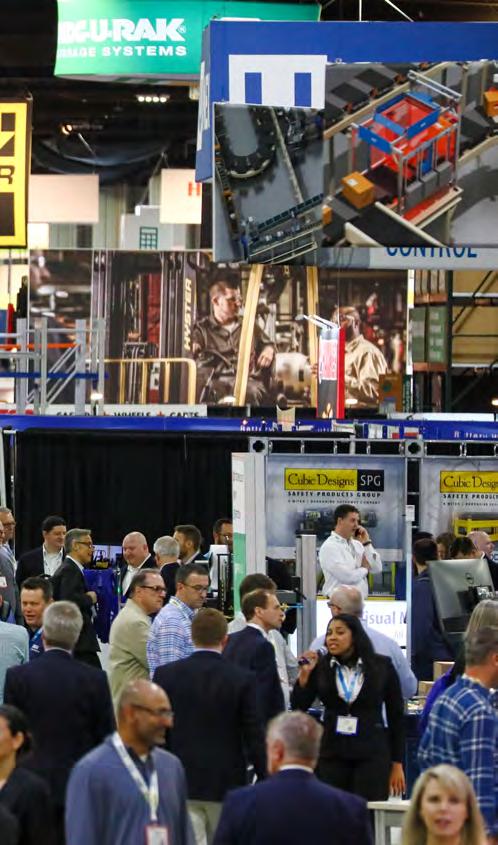
“The excitement on the show floor and the engagement in educational sessions is a sign of the overall power of the supply chain industry and the demand for the latest solutions and technologies in the space.”
– Daniel McKinnon EVP of exhibitions at MHI
senting the Fortune 500, the top 100 retailers, and top 100 consumer goods firms brought large teams to MODEX with plans in hand and budgets in place to make large supply chain investments.”
The MODEX Supply Chain Conference sessions included 200 educational seminars and five keynotes. On March 11, Bill Seward, President, UPS Supply Chain Solutions, spoke on the lessons he has learned at the front lines of UPS’s supply chain efforts. The March 11 afternoon keynote tackled the future of smart ports with representatives from the Ports of Rotterdam, Long Beach, and Virginia. Futurist Gerd Leonhard discussed the exponential change we will see in the coming age of AI in his March 12 keynote.
During the March 13 afternoon keynote, MHI’s John Paxton and Deloitte’s Wanda Johnson released the findings of the 2024 MHI Annual Industry Report: “The Collaborative Supply Chain – Tech-Driven and Human-Centric” during a panel discussion with four industry leaders. The report includes new insights into trends and technologies that are transforming supply chains and the priorities of the people who run them.
According to the report, 55 percent of supply chain leaders are increasing their supply chain technology and innovation investments with 88 percent saying they are planning to spend over $1 million.
Forty-two percent plan to spend over $10 million. This investment includes solutions for improved supply chain resiliency, transparency and as well as solutions for the ongoing workforce shortage.

Gig
the MODEX
companies showcased emerging supply chain tech and innovation. This award was chosen by supply chain professionals at the MODEX event. Gig and Take impressed the judges with their software solution, showcasing a user-friendly interface and the capability to offer flexible, accessible schedules to workers, effectively mitigating concerns related to labour shortages.
MHI also announced the winners of the 2024 MHI Innovation and Startup Awards on March 13 at MHI Industry Night. The MHI Innovation Award educates and provides valuable insights on the latest manufacturing and supply chain products and services. Exhibitors were called to submit a new product, product line, technology or service or new application of existing products or technology that create quantifiable and sustainable results in ROI, cost savings, and customer satisfaction.
A panel of volunteer judges from the industry assessed the 193 submissions for this year’s awards.
Three finalists were chosen and announced in each category - Best Innovation of an Existing Product, Best IT Innovation, Best New Innovation, and Best New Innovation in Sustainability based on concept, value, and impact.
The 2024 MHI Innovation Award winners are:
• Best Innovation of an Existing Product - ForwardX Robotics
• Best IT Innovation - Configura, Inc.
• Best New Innovation - Slip Robotics
• Best New Innovation in Sustainability - Avery Dennison
ForwardX won for its Apex C1500-L Autonomous Forklift, which has an array of multi-line LiDARs and obstacle recognition cameras. It surpasses conventional CE certification standards. The Apex C1500L’s design allows for the autonomous recognition and adjustment to pallet pockets, irrespective of the pallets’ orientation.
Configura was recognized for its for its CET Material Handling product. CET operates in 2D and 3D and uses Parametric Graphical Configuration (PGC) technology to eliminate errors, improve efficiency and streamline the design process. Real-time Bill of Materials, pricing, and comprehensive documentation creation contribute to error reduction and overall project success.
“I’m so proud and happy to be a part of this great team and the work we have accomplished to position Configura at the forefront of the material handling industry,” said Stefan Persson, CEO of Configura. “After more than 30 years, we continue to produce innovative products and services for the global design community and remain committed to listening to our customers and developing our products to best suit their needs.”
Slip Robotics won the innovation award for its SlipBot Automated Loading Robots (ALRs). The system allows a truck to be unloaded in five minutes. SlipBot ALRs carry 10 to 20 pallets per minute (and other freight types, including parcels) between any trailer and staging area.
Companies using SlipBots have increased dock throughput by 300 percent, reduced truck and trailer idle time by 91 percent, reduced labour downtime costs by 85 percent, reduced total freight damage by 40 percent, and even increased total facility output by 20 percent by freeing up productive space in the facility.
Avery Dennison’s linerless labels were recognized for sustainability. They produce no liner waste, no matrix waste, and no media is used between labels resulting in 50 percent more labels per roll and 32 percent less material used vs standard linered product. A switch from DT Linered product to DT Linerless results in 49 percent reduction in carbon and 34 percent reduction in water.


Nokia’s internal start-up AIMS is offering autonomous inventory taking using drones. The idea got its start from a customer doing vertical farming, said Paul Heitlinger, General Manager of Nokia AIMS, in an interview. They needed a solution that could easily look in on baby plants that were high off the floor in rack structures. A camera-equipped drone solved the problem and is now being marketed for warehouse inventory.
But, Heitlinger said, flying a drone autonomously indoors is a big challenge, and that’s the secret sauce that Nokia AIMS is bringing to the space. With that solved, their system takes images of every bin, every shelf and can scan the barcodes on items and the racking. It takes inventory overnight, or while the warehouse is quiet.
On the back end pulling the data into the WMS, users can see exactly what is where in the warehouse, and can compare real locations with where things were expected to be. If something is not where it was meant to be or there is something where it shouldn’t be the user can pull up an image of what the drone saw for visual confirmation.
It’s sold as a service with a monthly fee, and AIMS says it can realize a 40 percent ROI over three years, depending on the warehouse. The system works well for customers who need extremely high accuracy, like 3PLs with service level agreements, Heitlinger said.
Exoskeletons have been around for quite a while in the warehouse and manufacturing industries, but this year a couple start-ups are offering new takes on the back-saving tools.
Herowear is a start-up that’s making a passive, elastic-band powered unit. The second generation, lightweight Apex 2 unit works like an extra set of back muscles, said
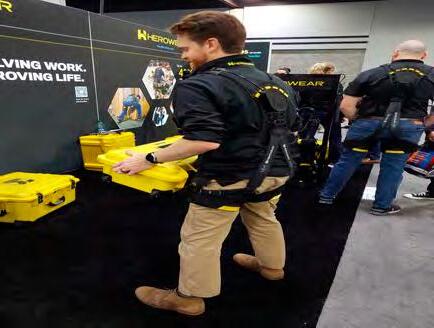
Paul Nicholson, VP of growth at Herowear, in an interview.
“It feels very natural for the user,” he said. “Our whole focus is on making the assistance as comfortable as possible.” To that end, the unit is entirely made of textiles, and is modular, so it can be customized to just about any size of user.
Two elastic bands connect from the shoulders over the buttocks to leg straps and can be connected or disconnect using a manual clutch on the shoulder strap. When it’s done up the bands assist the user when they bend and lift.
Nicholson recounted a Canadian use case where workers needed to move an 80-pound item around on their own in remote locations. They employed the Apex suits and were able to complete the job with no injuries.
Bigger customers in include DHL, Toyota, General Motors, and the US Army. A US grocery chain not only a 30 percent improvement in worker reports of wellbeing, they also saw an eight percent increase in productivity in their initial trial of the exosuit in their warehouse.

A suit will last three to five years with daily use, with the bands needing replacement about once a year. The cost is variable based on the number of units, and ranges from US$1,000 and $1,300 per suit. The suits can pay for themselves in three months, Nicholson said.
Competitor Verve Motion brings a different exosuit concept to the warehouse. Their suit is powered, and equipped with sensors that monitor the user’s activities. It can be used to help train workers to lift better and more safely, as well as offloading up to 40 percent of the weight being lifted.
The unit weighs about six pounds, including the motor and batteries. The motor pulls on a pair of straps that mimic the back muscles when the user is lifting. Batteries last about 12 hours. Accelerometers provide data about how the user is moving back to an app that managers can use to keep track of throughput, safe movement and more.
The units are sold on a robotics as a service basis, with a full warranty, and are expected to last about five years with constant use. Ignacio Galiana, CEO and co-founder of the company, said that RAAS model allows them to roll out upgrades on a continuous basis. Preventive maintenance like replacing the straps is done on site.
Galiana said that about 1,000 units have been deployed so far since the company’s inception in 2020, including with a Calgary-area customer he was not able to name. ROI is expected in four to five months, so customers are paying from January through May, and essentially seeing the rest of the year free.
https://www.insidelogistics.ca/subscribe/magazine/
Full Name: Company:______________________ Title:___________________ Address:_____________________________________________________________________________
Phone: ______________
YES, I WISH TO RECEIVE INSIDE LOGISTICS MAGAZINE FREE!
YES, I WISH TO RECEIVE INSIDE LOGISTICS E-newsletter FREE!
Choose your Edition: Print Digital Print & Digital
Signature:
(Email Required
Date:
PLEASE ANSWER THE FOLLOWING QUESTIONS TO QUALIFY FOR YOUR FREE SUBSCRIPTION:
1. Do you purchase, or influence the purchase, of goods and/or services related to distribution logistics, including warehousing operations (receiving, storage or shipping) or inventory control or materials handling? Yes No
2. If Yes, do you have plans to buy any of the following in the foreseeable future? (Check as many as apply)
(A) Forklifts and mobile materials handling equipment
(B) Racking, shelving and storage equipment
(C) Software, eg WMS, TMS, YMS, WES, etc
(D) Automated materials handling systems
(Z) None of the above
TRANSPORTATION SERVICES:
(E) Third-party logistics services
(F) Transportation services
(G) Real estate, warehouses, existing or new building
(H) Data capture and inventory control equipment
LTL Trucking Truck Load Trucking Intermodal Marine Rail Courier Air Freight None
3. What is your company's PRIMARY business?
MANUFACTURING (Check one only)
(01) Food & Beverage
(02) Consumer Durables
(03) Paper & Print
(04) Automotive Parts
(05) Clothing, Apparel & Textile Products
(06) Chemicals, Petroleum & Hazardous Waste
(07) Pharmaceuticals
(09) Computers & Electronics
(10) Transportation Equipment
(11) Lumber & Building Materials
(12) Manufactured Industrial Inputs
(98) Other Manufacturing (please specify)________________________________________________________________________
NON-MANUFACTURING (Check one only)
(13) Agriculture, Forestry, Fishing & Mining
(14) Transportation Services
(15) Storage & Warehousing Distributor
(16) Distributor
(17) Construction
(18) Retail Trade
(99) Others Allied to the Field (please specify)____________________________________________________________________
4. Which of the following categories best describes your PRIMARY function? (Check one only)
(A) Executive Management (E) Financial / Administrative Management
(B) Purchasing / Procurement
(C) Engineering / Design Engineering / Research & Development
(D) Storage & Warehousing
(Z) Other (please specify)____________
5. What is the approximate number of employees at this location?
(F) Plant Production / Operations / Maintenance Management
(G) Transportation & Distribution
(H) Materials Management

A constant headache for warehouse managers is the disappearance of the mobile devices employees use to scan and track inventory. Tablets, keycards, scanners and portable label makers all are frequently misplaced, stolen or accidentally taken home by absent-minded workers.
A new product from Traka aims to make these problems a thing of the past. The company’s intelligent shared asset management lockers provide secure storage, charging and access control for all kinds of devices.
Biometric access control prevents the wrong user from checking out a device, and scheduling returns prevents lineups at the end of the day as well as ensuring devices get back and charged up before the next shift. The system is also designed to help manage multiple locations from one central control point.
“It seems like a basic concept, but in terms of ROI in time spent looking for lost assets, having to re-key a facility or devices falling into the wrong hands, especially when you are talking about scanners, When you see how long it takes to get them back in and how expensive they are, it just makes sense,” said Brian Davidson, the company’s regional sales manager, in a show-floor interview.
Davidson also pointed out that with high employee turnover in warehouses, being able to instantly control who has access from the back-end software is a huge advantage. “Before that employee leaves the premises, their access can be revoked,” he said.
Combilift had its only North American example of the new the CombiCB70E on display at the show. The electric forktruck is the latest addition to Combilift’s range.
Combining a 7,000-kg lift capacity with a small footprint, the CB70E has been designed to enable operators to move bulky loads more easily in tighter areas. Typically, counterbalanced forklifts will measure 3.5m from the face of the fork the back of the machine. With the CB70E, that measurement is 2.68m – almost a metre smaller.
“We see this as a huge benefit in both timber and steel applications,” said Colin Gray, Combilft’s regional manager for Norway and Finland. “For anybody handling awkward loads of seven tonnes or more, manoeuvrability is key.” Another feature of the CB70E is its independent traction system, which eliminates the need for differential lock on slippery surfaces and reduces long load momentum twisting when travelling laterally. The system is programmed to ensure every wheel is always rotating at the correct speed.
“We see a lot of applications such as sawmills where the yards aren’t paved, so operators are often dealing with rough surfaces and potholes,” he said. “With the CB70E’s extra-large wheels, we see applications like these as a huge potential market for us.”
According to CEO and Co-founder Martin McVicar, electric equipment like the CB70E is now the focus of about 98 percent of the company’s research and development (R&D) resources. “We’re focussed on making vehicles that are more environmentally friendly to use, as well as vehicles that enable our customers to make their warehouse utilisation more environmentally friendly,” he said. “The increased capacities that we are offering in our electric range will answer the demand for ever more powerful products, while at the same time helping companies to achieve their aims for more sustainable operations.”

VisionNav Robotics launched its automatic trailer truck loading and unloading solution, the newly unveiled VNST20 PRO AGV robotics. The company demonstrated loading and unloading trailer trucks in just 45 minutes.
Combining VisionNav’s high performance autonomous forklift VNST20 with an advanced Robot Control System (RCS) for fleet scheduling and 3D LiDAR SLAM deep learning positioning technology for accuracy, the flexible solution has been designed specifically for trailer trucks, automating loading, unloading, and manual handling tasks. It will be available in 2025.
Kardex unveiled its FulfillX solution, specially designed by expert automation engineers to maximize the capabilities of AutoStore robotic cube storage systems and deliver the fast order fulfillment.
Kardex teamed up with cube storage pioneer AutoStore to launch
FulfillX, demonstrating how the innovative warehouse execution system (WES) can maximize the potential of automation and robotics.
Kardex’s Intuitive Pick Assistant offers a user-friendly picking display. It is compatible with both Kardex Remstar and AutoStore ports to facilitate accurate, ergonomic picking.
“MODEX 2024 was the ideal opportunity to showcase the real-world success apparel company Cutter & Buck has had in North America with FulFillX,” said Mitch Hayes, president of Kardex Solutions AutoStore.
“FulFillX has been designed to enhance the power of AutoStore, helping companies meet and exceed their business cases quickly by providing exceptional results within months. The modern microservices backend and simple window have been developed by our team of experienced automation engineers with extensive experience of AutoStore and complementary technologies.”
Harold Vanasse, senior director of marketing, motive power global at EnerSys, discussed a few of the company’s newest solutions.
“Labour is a big challenge our customers have been facing –even before the pandemic. With a roughly 43 percent turnover rate in warehousing, many customers are looking to become more resilient by automating their operations as much as possible,” said Vanasse.
“To help achieve true automation, our NexSys AIR wireless charger eliminates the need for workers to monitor and maintain mechanical charging connections. While compatible with all our major battery technologies, it’s a perfect match with our NexSys maintenance-free batteries to help AGV fleets operate more productively and autonomously.”
The NexSys AIR wireless charger has contact-free charging pads - eliminating the maintenance and wear associated with physical connections. It integrates into a range of AGV applications with charging stations that
can be installed in a variety of locations throughout facilities.
“Between price volatility for fossil fuels and 67 percent of companies planning to hold supply chains responsible for environmental KPIs, customers running outdoor fleets or specialized attachments are looking for alternatives to internal combustion engine powered equipment,” added Vanasse.
Enersys showed its new 80-volt NexSys iON battery and NexSys+ Outdoor charger. Whether alone or used together, these provide many traditional Class 4 and 5 internal combustion engine fleets the ability to go electric - reducing emissions and carbon footprint. “In addition to being highly energy efficient, our entire line of maintenance-free NexSys batteries does not require watering, which results in water savings as well,” Vanasse said.

The new IP54-rated NexSys+ Outdoor charger brings the advanced performance of the popular NexSys+ charger to equipment operating at building material yards, airports, farms, rental facilities, ports, cargo terminals and other working environments exposed to the weather.
“We’re always trying to understand customer needs and apply a ‘total systems approach’ to achieving their goals. These new products expand our ability to apply that approach for customers deploying AGVs and electrifying outdoor equipment,” Vanasse said. “Our full array of options enables us to address a lot of our end-users’ application challenges –whether indoors or outside, human-driven or automated.”
The global automotive logistics market size in terms of revenue was estimated to be worth USD$256.85 billion in 2020 and is poised to grow from $262.06 billion in 2021 to $393.71 billion in 2028, growing at a CAGR of 6.0% from 2021 to 2028.
The number of EVs on the road expected to hit 125 million by 2030.
A diesel Class 8 truck costs roughly US$180,000, while a comparable battery-electric truck costs over $400,000.

A million miles
Schneider National’s battery electric vehicle (BEV) fleet has hauled more than a million zero emission miles (1.6 million km) of customer freight. The company’s fleet of 100 Freightliner eCascadias includes 92 battery electric trucks and two electric yard spotters.
The eCascadias have prevented approximately 3.3 million pounds (1.5 million kg) of carbon dioxide emissions – the equivalent of removing more than 330 gas-powered passenger vehicles from the road for a year. The eCascadias achieve an 80 percent charge within 90 minutes and have a typical driving range of up to approximately 220 miles.
Full electrification of the U.S. commercial truck fleet would require nearly $1 trillion in infrastructure investment alone, according to a new report released by the Clean Freight Coalition. upwards of $620 billion in charging infrastructure alone, including chargers, site infrastructure and electric service upgrades. Utilities would need to invest $370 billion to upgrade their grid networks to meet the demands of just commercial vehicles.
Heavy-duty vehicles require 3x infrastructure investment per vehicle compared to medium-duty for depot charging.
Researchers at Chalmers University of Technology in Sweden have shown that it can be cheaper to run heavy goods vehicles on electricity than on diesel. In a real-world test heavy goods vehicles drove the 553 kilometres between Helsingborg and Stockholm in Sweden. Researchers compared two different battery sizes and two possible prices for fast charging, and found it possible to electrify this type of vehicle in a cost-effective way. They assumed a low diesel price and concluded that it is profitable for a haulage company to electrify its fleet of HGVs, with the exception of vehicles that mostly load up to their maximum allowed weight.
THE DAWN OF industry 4.0 is upon us. The road to future success is paved with digitization and automation.
A report published by PWC shows that for Industry 4.0 to be realized, most enterprise processes must be digitized. This can include analytics, smart warehousing, logistics visibility, and a plethora of other areas along the supply chain.
McKinsey & Company defines Industry 4.0 as the next phase in digitization of the manufacturing sector, driven by disruptive trends including the rise of data and connectivity, analytics, human-machine interaction, and improvements in robotics.
According to Gartner’s 2022 “Supply Chain Technology User Wants and Needs Survey” (UWaN):
• 96 perecnt of respondents have already deployed or plan to deploy cyber-physical automation by 2024.
• There will be more than two million intralogistics smart robots by the end of 2024.
• By 2027, 50 percent of companies with warehouse operations will leverage AI-enabled vision systems to replace traditional cycle counting processes.
• And by 2028, there will be more smart robots than front line workers in manufacturing, retail and logistics due to labour shortages.
But the shift in processes and technology will also heavily impact the talent section of our human operated processes. This evolution of the AI generated supply chain will require current employees and new employees to continue to increase their skill levels and techniques for current roles and for future roles that we haven’t even heard of yet.
Nick Nanos, senior supply chain officer at LCBO, Ontario’s liquor retailer, views AI and digitization as something we should embrace, not fear: “I think that human connection is critical. There will always be jobs in certain areas, they’re just going to be different. It’s like automated warehouses today versus the conventional buildings of thirty years ago;


there are better jobs in most cases with better trained people that are more technicians and engineers working in these automated facilities. And I think it’s the same in so many other roles. I think it’s going to make our lives that much better.”
When it comes to AI, Nanos says, “The reality is I welcome it, and I think it will be interesting and it’s a good skill to have for success, being open to change, embrace it.”
While attending the Manifest trade show and conference in Las Vegas in February 2024, I was able to hear about the implementation of generative AI from Nate Robert, CTO and chief product officer at Ryder Systems.
Robert described the adoption of generative AI as a three-wave process. The first wave is the advent of foundational models. The second wave utilizes shallow use-cases built on top of the foundational models using public data. The third wave is a long-term solution, where you have large companies with proprietary data sets and training them on top of the foundational models – that’s when you get deep insights.
The digitization shift can also be seen in port and drayage markets. Toni Ann Careccio, chief customer officer of the drayage operating platform PortPro revealed: “Drayage
is such a critical component of our supply chain; it’s been the black sheep for a long time and now it is really being looked at. It’s important because a lot of these drayage trucking companies are running on paper and pen, spreadsheets and EDI, and it’s really hard to create sufficient and sustainable supply chains when these companies themselves aren’t running efficiently.”
PortPro is providing full digital visibility in the first mile delivery model, allowing online booking, real time tracking, and document access to drayage carriers. Careccio believes that over the next 10 years the market will see as big a digital transformation in supply chain, specifically within drayage, that car services saw with Uber.
During a panel discussion at Manifest 2024 focusing on recent advances in connected and smart warehouses, A.K. Schultz, CEO and co-founder of SVT Robotics, explained that the future will showcase multiple types of technologies working in concert with each other. “One of those technologies is human beings. Right now, most systems cannot coordinate a manual picker with another picker, so you can’t handle peaks, and you have to treat human beings almost like robots that are just not made of metal.”
He further explains this concept, saying this is where multi-agent systems would come into play and employ a common data system allowing them to operate in the same field. But according to Shultz, “There is no one robot to rule them all.”
From smart robots and automation to AI-generating operating platforms, the supply chain is benefitting in the tech blitz currently buzzing around the world. However, I believe that in a world full of technology, it is human interaction that will be the glue keeping it all together. We can have machines and robots working to make us more productive and efficient, but without the human touch, without the human consumer, what is it all for? Only time will tell, and I’m ready to buckle in the for the ride.
IN THESE DAYS of trade disruptions and intense global competition, let’s look at critical minerals. As the name indicates, they are very important for industry.
Critical minerals are resources deemed essential to the economy and whose supply may be disrupted. The “criticality” of a mineral can change with time as society evolves. For example, salt was once a critical mineral.
Today, we are concerned about minerals needed for electrification. Because the mining and processing of these minerals is dominated by China, their supply could be subject to disruption.
The U.S. Energy Act of 2020 defines a “critical mineral’’ as any non-fuel mineral, element, substance or material with a high risk of supply chain disruption and serving an essential function in energy technologies. It lists the minerals critical for energy, called the “electric eighteen’’: aluminum, cobalt, copper, dysprosium, electrical steel, fluorine, gallium, iridium, lithium, magnesium, natural graphite, neodymium, nickel, platinum, praseodymium, silicon, silicon carbide and terbium. The U.S. secretary of the interior also maintains a list containing fifty minerals.
Most are raw minerals, though some are processed: aluminum is made from bauxite, a name that comes from a small French town called Les Baux, where the material’s property was first discovered in the early 1800’s. The aluminium produced in Canada is made from bauxite imported mainly from Guinea, West Africa, the world’s largest bauxite producer. Silicon is made from mixing and superheating quartz with a carbon source, so the raw material may be local.
Both industrial processes devour a lot of energy. Making aluminum consumes about 10 times the energy required to make steel. The production of silicon requires very high temperatures, also making it energy intensive.
Sometimes one wonders if these factors are taken into account when we look for solutions to reduce our carbon footprint.
Last month, our federal government announced plans to accelerate critical mining and boost our energy security by slashing the time it takes to develop new critical minerals mines, by providing faster permit processes.

 christian.siviere@videotron.ca
christian.siviere@videotron.ca
Ottawa focusses on six minerals, key to making electric vehicles and wind turbines: lithium, graphite, nickel, cobalt, copper and rare earth elements. Rare earths are a group of chemically similar metallic elements that are not especially rare but tend to occur together in nature and are difficult to separate from one another. There are 17 rare earth elements. Rare earths are critical for the production of magnets, a vital component of any electrical machine.
China accounts for 60 percent of the world’s extraction of rare earths and 90 percent of the processing. To maintain its quasi-monopoly, China introduced a ban on exports of rare earth extraction and separation technologies in December 2023.
Earlier this year, the World Trade Organization published a report on the role critical minerals play in the production of clean energy technologies. Over the last 20 years, trade in these minerals increased from US$53 billion to $378 billion.
The report mentions that a battery for an electric vehicle requires 200 kilos of critical minerals, and 70 percent of global demand for cobalt comes from the battery sector.
Worldwide imports of critical minerals have risen significantly, particularly the platinum group metals, rhodium, iridium, ruthenium and osmium. These recorded annual growth of 72 percent since 2017. Helium and lithium
also recorded impressive growth rates of 53 percent since 2017.
Imports of copper have increased 12 percent in the last five years, with China representing nearly 60 percent of the total. The most traded mineral is copper, representing 26 percent of total mineral imports, followed by unwrought aluminum at 20 percent. Following these, rhodium and palladium emerge as the most traded minerals, at 30 percent of the world’s total.
Chile is the world’s leading exporter of critical minerals, accounting for 11 percent of global exports, followed by South Africa (10 percent), with Australia, Peru and Russia at six percent. For earths, stone and ores, South Africa has a 14.3 percent global share, just ahead of Australia, followed by Guinea, thanks to bauxite.
Peru is the fourth-largest exporter, thanks to zinc, tin and molybdenum. Chile is the world’s leading copper exporter, with 25 percent of global exports, followed by Peru at 19 percent and Indonesia at nine percent. Seventy percent of worldwide graphite extraction and close to 100 percent of processed graphite production happen in China.
These figures give us an idea of the supply challenges facing these industries, particularly due to current geopolitical tensions, including Russia’s continuing invasion of Ukraine and the Hamas-Israel conflict.
One has to wonder, though, if drilling more holes into the ground to produce greener energy is the solution to save the planet.
Should we not, instead, try to consume less energy? How about driving fewer cars and promoting public transit solutions? The best-selling vehicles in Canada and the US are not fuel-efficient sedans or compact cars, they are pick-up trucks, followed by large SUVs.
And speaking of energy consumption, the constant rise of e-commerce is obscene. Amazon’s growth may have peaked but new players like Temu and Shein are gaining market share in North America, with fast-fashion leading their growth. Even if the trucks that deliver the merchandise are electric and the Temu/ Shein fulfillment centres use clean energy, all requiring more critical minerals, is this really sustainable?
Updated CSA guideline provides step by step process for effective rack inspections
STEEL STORAGE RACKS need to be inspected and maintained on a regular basis to prevent racking collapse and product falling, with potential catastrophic consequences, such as critical injuries and fatalities, financial penalties, and product losses. Racking collapses have occurred more often than people may realize.
To prevent racking failure, supervisors, joint health and safety committees (JHSC) and maintenance staff need to have a comprehensive understanding of the importance of each racking component, what damage looks like, what makes a load unstable and the capacity of the structure.
One of the best tools to develop this understanding is CSA A344:24, User guide for steel storage racks, released in 2024. Having a working knowledge of this guide is an integral part of becoming competent to complete racking inspections.
Occupational health and safety laws across Canada, both provincial and federal, place a legal duty on employers to ensure that workplace inspections, which include storage racks, are carried out on a regular basis, often monthly. Many companies choose to inspect more frequently due to the high volume of pallet movement and extensive mobile equipment traffic within their workplace. A more in-depth inspection should also be carried out once a year.
Among other things, the CSA guideline provides detail on: the components of racking the use of racking modifications to racking the assessment of damage and deficiencies types of corrective actions you can take This is the third edition of CSA A344, replacing the previous edition published in 2017. The CSA working group has enhanced this edition to make it more reader-friendly and easier to find pertinent information and answers to your questions. Photos and illustrations have been updated to provide clearer and more accurate visual interpretation of the technical content.


the guide can help you
Each component of a rack (in proper position) plays an essential role in allowing the rack to support the weight it was designed for. The overall strength of the rack depends on each component maintaining its original shape; once you change the shape, you change the strength. Therefore, damaged or out of position components must be identified and corrected.
The guideline can help companies prevent racking collapses and injuries by teaching workplaces inspectors to:
1. identify parts of the rack and recognize the types of damage that can occur. When inspecting racking, take the time to be thorough. From row end protectors and cross aisle ties to diagonal and horizontal braces, each part contributes to the stability and strength of the entire rack. Damage to something even as small as a beam connector locking device may cause an entire beam to become dislodged, weakening the entire structure.
2. Understand how damage occurs, and its impact. Most damage occurs at the bottom five feet of the rack when it is inadvertently struck by lift trucks. This may occur when an
operator turns into racking with an obstructed view or the aisle space is too narrow for the turning radius of the lift truck. Racking inspectors need to consider why damage occurs so they can address the root cause. The CSA guide teaches your employees how to measure damage with input from professionals, and stresses the importance of prompt and timely corrective action.
3. Recognize why it’s important for workers to report racking damage and near misses. Encouraging all workers to report damage and near misses allows the company to take corrective action before an injury occurs. Employers need to create a comfortable workplace culture for them to do this. If employees think they will get disciplined as soon as they report an incident, they will be less likely to report. Thank those who come forward, and use it as a learning opportunity for other employees during a pre-shift meeting or safety talk.
4. Understand how modifications can undermine the racking structure. Changes to the rack structure can have strong safety implications. For example, it is common to move the lower beam up from the recommended position to store bulky items; however, this may affect the capacity of the rack. Part of the inspection process involves identifying and documenting any alterations to the original load application and rack configuration drawings (LARC), if these exist. Unnecessary modifications, when combined with damage, can considerably weaken the structure. There may be legitimate reasons for modifying racks, and the guideline explains how this can be completed safely without affecting the integrity of the entire pallet rack.
5. Understand the purpose of a more detailed, yearly, inspection. Whether this is carried out in-house or using outside experts, the goal is to look for hidden hazards that may not be visible during monthly inspections. This may require moving some pallets or even inspecting at higher elevations. These more detailed inspections may also review the quality of previous monthly inspections.






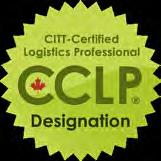
For 65 years, elite logistics professionals have set themselves apart with the CCLP designation. Take your first step to join them this spring, and start online May 6
CCLP (CITT-Certified Logistics Professional) is the one and only professional certification granted by CITT –Canada’s Logistics Association. Created by industry, for industry, CCLP develops and certifies the crucial competencies required of an elite logistics professional.
When you hold the CCLP designation, it tells the industry – from carrier across modes to shippers in all sectors – that you have an expert understanding of the complex business of logistics. And it connects to you an unparalleled network of like-minded professionals who can share expertise and open new doors.
Whether you’re looking to sharpen your abilities, advance in your current organization, unlock new opportunities, or get formal recognition for the expertise you already have, CCLP can help you achieve your career goals.
Get certified via the fully online program or the challenge exam for professionals with deep experience • Access networking events, exclusive job board, topical webinars, and other exclusive resources • Fast-tracks available for previous business education • Recognition of international education and work experience



To stay competitive and get ahead, you need innovative, scalable and safe solutions. These solutions can help with better storage, distribution, fulfillment or any combination that can grow with your business as it adapts to change.
As your partner in facilities evolution, you can count on Konstant to transform your facilities. Collaborate with our team to optimize your facility today and evolve, anticipate, adapt and imagine the facility of your future.

Get integrated logistics solutions: racks, shelving, trucks and robotics from our partners including Johnston Equipment and GNJ Automation.
Access comprehensive services for your project lifecycle, from planning to ongoing management with a skilled team ensuring quality at every step.
For more than 50 years, Konstant has served businesses across Canada, adapting our services to evolving facility management needs.